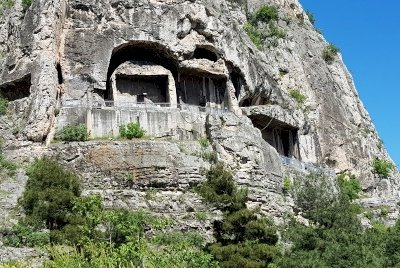Turkiye
Mount Harsena & the Rock-tombs of the Pontic Kings
Mount Harşena and the Rock-tombs of the Pontic Kings comprises a landscape of limestone rock formations in which tombs were carved. The tombs hold the remains of the 5 Pontic Kings. They are Hellenistic in their design, with round-arched facades. They date from the 3rd and 2nd century BC. This mixed proposal also includes the river valley they lie in, Amasya Fortress and an Ottoman neighbourhood with wooden houses.
Site Info
Official Information
- Full Name
- Mount Harşena and the Rock-tombs of the Pontic Kings (ID: 6039)
- Country
- Turkiye
- Status
-
On tentative list 2015
Site history
History of Mount Harsena & the Rock-tombs of the Pontic Kings
- 2015: Added to Tentative List
- Added to tentative list
- Type
- Mixed
- Criteria
Links
- UNESCO
- whc.unesco.org
All Links
UNESCO.org
- whc.unesco.org — whc.unesco.org
Community Information
- Community Category
- Natural landscape: Mountain
- Secular structure: Burial
Travel Information
Recent Connections
News
No news.
Recent Visitors
- Evgenii
- henryjiao18
- Roman Bruehwiler
- Thomas van der Walt
- George Gdanski
- Alexander Lehmann
- Can SARICA
Visitors of Mount Harsena & the Rock-tombs of the Pontic Kings
Community Reviews
Show full reviewsWojciech Fedoruk
Mount Harsena & the Rock-tombs of the Pontic Kings
Mount Harsena & the Rock-tombs of the Pontic Kings (On tentative list)

Amasya was on our way from Ani to Istanbul and, considering it required only a short detour from main E80 road, I decided to go there. It was Saturday afternoon and the town was bustling with tourists. There is no doubt the town is worth its popularity – it was undisputedly one of the most beautiful places in Turkey we visited. The town, like many Turkish settlements, is located on the slope of Mount Harşena, along the river of Yeşilırmak and its city center is well preserved. The buildings just on the river bank are really picturesque. To fully admire the beauty of the town one has to climb up the mount Harşena. As a WHS fan I had to do it anyway because the mountain is on Turkish Tentative List. The uniqueness of Harşena stems from stone tombs carved in its slopes. The tombs were carved by several Pontic kings, who resided in Amasya as a capital of the kingdom from 3rd century BC.
The Pontic Kingdom was established by Persian satrap Mithridates who adopted Persian tradition of rock tombs (of which the most prominent example is Naqsh e-Rostam near Persepolis). The ones carved in Harşena are very big – up to 15 meters high, but in terms of artistic value are far away from their Iranian counterparts. I dare say they look much nicer from a distance than near. There are no reliefs, just carved caves with small entrance (you cannot look into the tombs but I …
Keep reading 0 comments
